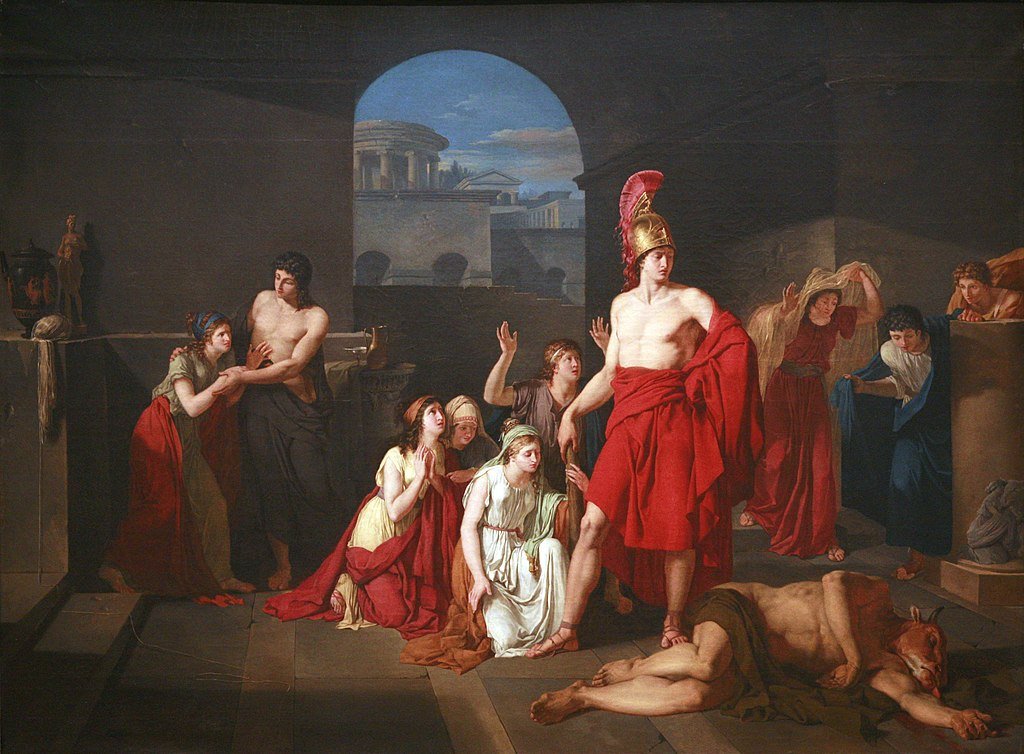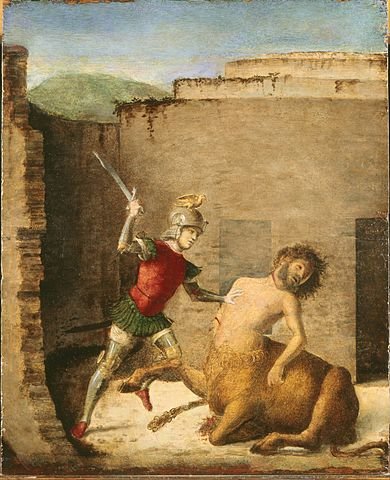The tale of Theseus and Minotaur stands as an iconic representation of courage, determination, and sacrifice in Greek Mythology. Theseus, the celebrated Athenian hero, ventures on a dangerous mission to confront the fearsome Minotaur, a monstrous creature dwelling within the labyrinth of Crete.

Theseus defeats the Minotaur and escapes with fellow Athenians. However, a tragic oversight with his sail color leads to King Aegeus’ mistaken belief in Theseus’ death, resulting in his own demise. Theseus becomes the new king of Athens, and the myth continues to inspire art, symbolizing bravery and the unyielding force of fate in shaping lives.
The Characters
Theseus: A renowned figure in Greek mythology, Theseus was revered as an early king of Athens. During the Classical period, he embodied the ideal Athenian, a just man of action devoted to serving his city and a staunch defender of democracy. His legendary exploits included the defeat of villains, Amazons, and centaurs, earning him great acclaim. Theseus became a central figure in various Greek tragedy plays, while his heroic encounter with the Minotaur remained a favorite subject for Greek vase painters.
Minotaur: The Minotaur was a fearsome creature with the body of a man and the head and tail of a bull in Greek mythology. It was the result of the union between the Cretan Queen Pasiphae and a majestic bull. To confine the Minotaur, King Minos tasked the skilled craftsman Daedalus and his son Icarus to construct a vast maze known as the Labyrinth. Within its walls, the Minotaur was kept, receiving annual human offerings to satisfy its appetite. Eventually, the Athenian hero Theseus bravely confronted and defeated the monstrous Minotaur, bringing an end to its terrifying reign.
King Minos and The Minotaur at The Labyrinth Of Crete
The Minotaur, a creature half man – half bull, was born to Pasiphae, the wife of King Minos of Crete, after sleeping with a bull sent by Zeus. Embarrassed by the creature’s existence, King Minos concealed the Minotaur in the Labyrinth, a complex maze built by Daedalus at the Minoan Palace of Knossos. As the myth goes, Minos used the Labyrinth to imprison his enemies, offering them as sacrifices for the Minotaur to devour.
During the construction of the Labyrinth, King Minos received devastating news that his son Androgeos, the only human offspring of Minos and Pasiphae, had been killed. Various sources offer different accounts of his death: some claim that he was slain by jealous Athenians due to his exceptional skill in the Panathenic Games.
However, an alternate version of the myth suggests that King Aegeus of Athens, angered by Androgeos’ victories, sent him on a mission to defeat the invincible Marathonian Bull. Tragically, Androgeos was killed by the bull and, indirectly, by the actions of the Athenians.
This loss further fueled King Minos’ desire for retribution and led to the implementation of the human sacrifices to the dreaded Minotaur in the Labyrinth. King Minos demanded that King Aegeus of Athens send seven youths and maidens every year (in some versions, every seventh or ninth year) as a tribute to the Minotaur, appeasing the plague caused by Androgeus’s death.
The Athenians sought guidance from the Oracle of Delphi, who advised them to fulfill whatever demands King Minos made. Despite this counsel, the death of Androgeos brought forth a merciless plague upon Athens, as recounted by Catullus. Only when King Aegeus discovered that sending tributes to the city state Crete and complying with Minos’ demands would save Athens from the plague, he reluctantly agreed to do so.
Theseus Volunteers to Be The Sacrifice
In the third year, Theseus, the valiant son of King Aegeus of Athens, volunteered to be one of the sacrifices, intending to slay the Minotaur and end the gruesome human sacrifices. Despite his father’s pleas, Theseus remained resolute and promised to return with white sails if successful, while black sails would signify his death.
In Crete, the daughters of King Minos, Ariadne, and Phaedra, both developed profound feelings for Theseus. Distraught at the thought of Theseus falling victim to her half-brother, the Minotaur, Ariadne sought assistance from Daedalus. Pleading with the skilled craftsman, she asked him to reveal the secret of escaping the Labyrinth.
Daedalus shared the information, and Ariadne hurried to inform Theseus before he ventured into the treacherous maze. Following Daedalus’ instructions, she handed Theseus a ball of thread, which would serve as a tool to help him find the way out of the intricate Labyrinth.
Theseus Kills The Minotaur
Guided by Daedalus’ advice, Princess Ariadne handed Theseus a ball of thread. As Theseus went into the maze, he secured one end of the string to the entrance and proceeded deeper inside. In the heart of the Labyrinth, he confronted the fearsome Minotaur and bravely defeated the monstrous creature, either with his bare fists or the sword of Aegeus.

Unlike the unfortunate victims before him, Theseus successfully found his way out, all thanks to Ariadne’s precious gift. Simply following the thread’s path, he retraced his steps, leading him back to the labyrinth’s entrance. With his remarkable feat, Theseus rescued the other Athenians trapped within and swiftly departed for Athens, accompanied by Ariadne and Phaedra.
Theseus Journeys Back to Athens
During the voyage back to Athens, Theseus unexpectedly abandons Ariadne on the island of Naxos, sailing on with his intended bride, Phaedra. In one version, Ariadne falls asleep on the shore, missing the boat to Athens. Left alone on Naxos, she contemplates her actions and regrets assisting Theseus in slaying her half-brother, the Minotaur, hoping he would marry her in return.
However, fate had other plans for Ariadne. The god Dionysos discovers her on Naxos and falls in love with her, ultimately marrying her. In some accounts, Dionysos even intervenes, instructing Theseus to leave Ariadne, as he intends to make her his wife.
Meanwhile, Theseus, overjoyed with the prospect of returning home with Phaedra, forgets to change the color of his sails from black to white as promised to his father, King Aegeus. Upon seeing the black sails from afar, Aegeus assumes his son is dead and, consumed by grief, tragically ends his life by plunging into the sea. Theseus’ becomes the new king of Athens and gives rise to the name of the Aegean Sea, forever intertwined with the myth of Theseus and the Minotaur.
Summary of The Myth of Theseus and Minotaur
Theseus, a heroic figure from Athens, embarks on a courageous mission to slay the fearsome Minotaur, a half-man, half-bull monster imprisoned in the labyrinth of Crete. The Minotaur’s birth and King Minos’ demand for human sacrifices add to the tragedy. Princess Ariadne, in love with Theseus, gave him a thread to navigate the labyrinth.
Theseus successfully killed the Minotaur and escaped with Ariadne, who is later left on Naxos. However, he tragically forgot to change the sails on the return journey, causing his father, King Aegeus, to believe he was dead and commit suicide. This compelling myth has inspired artistic creations across the ages, celebrating the heroism and sacrifice of Theseus.
Theme of The Myth of Theseus and Minotaur
The myth of Theseus and the Minotaur revolves around themes of courage, determination, and sacrifice. It also highlights the concept of destiny, emphasizing that one’s life path is influenced by the gods. Theseus’s father’s choices, despite warnings, resulted in tragic consequences and showed the inevitability of fate.
Theseus’s bravery and resolve to face the Minotaur in the labyrinth showcase the importance of perseverance and heroism. The story serves as a reminder that while destiny may be challenging, one must confront it with strength and determination to overcome adversity.
Also Read: Eros and Psyche
